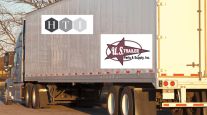Technology Used to Strengthen Truck and Trailer Inspection Procedures
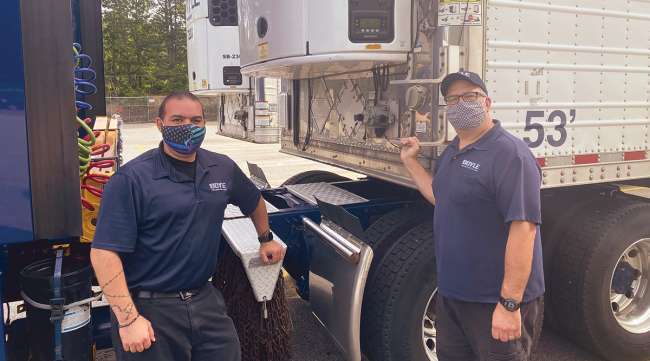
[Stay on top of transportation news: Get TTNews in your inbox.]
Pre- and post-trip inspections play a pivotal role in identifying equipment maintenance problems early, which helps prevent roadside violations and minimizes vehicle downtime. Given the importance of these routine inspections, many fleets have implemented technology to guarantee drivers are conducting them properly and to transmit the findings early.
They also are using technology to increase driver awareness and engage them in the pre-trip inspection process.
“On a mechanical side, drivers need to be thorough on their pre- and post-trip every single day,” said Shana Hatch, Compliance Safety Accountability manager for refrigerated carrier C.R. England Inc. “They need to be aware of how the equipment looks and feels and what they see walking past.”
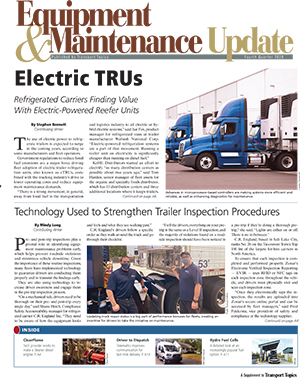
►Refrigerated carriers finding value with electric-powered reefer units
►Technology used to strengthen truck and trailer inspection procedures
►Technology provider hopes to strike balance on diesel engine
►Telematics strengthens communication between delivery driver and dispatch
►Baxter: Considerations for hydrogen-electric trucks
C.R. England’s drivers follow a specific order as they walk around the truck and go through their checklist.
“I tell the drivers, everything on your pre-trip is the same as a Level II inspection, and the majority of violations found on a roadside inspection should have been noticed in a pre-trip if they’re doing a thorough pre-trip,” she said. “Lights are either on or off. There is no in-between.”
C.R. England, based in Salt Lake City, ranks No. 26 on the Transport Topics Top 100 list of the largest for-hire carriers in North America.
To ensure that each inspection is completed and performed properly, Zonar’s Electronic Verified Inspection Reporting — EVIR — uses RFID or NFC tags on each inspection zone throughout the vehicle, and drivers must physically visit and scan each inspection zone.
“Once they electronically sign the inspection, the results are uploaded into Zonar’s secure online portal and can be accessed by fleet managers,” said Fred Fakkema, vice president of safety and compliance at the technology supplier.
Boyle Transportation takes a multifaceted approach to ensure thorough inspections, said Michael Lasko, manager of safety and quality for the Billerica, Mass.-based fleet.

Home | Video | Heroes' Photo Gallery
Saluting the men and women of the trucking industry who kept America's essential goods flowing during the coronavirus pandemic.
Heroes: Peter Lacoste | Susan Dawson | James Rogers | Reggie Barrows | Kevin Cooper | Cesar Quintana Moreno
A central tool is Fleetio, a fleet management software and app provider. Drivers conduct inspections using the Fleetio app and submit driver vehicle inspection reports — DVIRs — electronically.
Lasko said Fleetio has streamlined the lines of communication between its professional drivers and the maintenance department.
“If they have a problem, they open the app, enter in what the issue is, and our maintenance department acts on it,” he said.
The app also stores the previous six months of maintenance history on each piece of equipment.
“You could then look at it and say, ‘Mike reported two weeks ago this trailer had low tread depth,’ so right away you know if there is something that needs attention,” Lasko said.
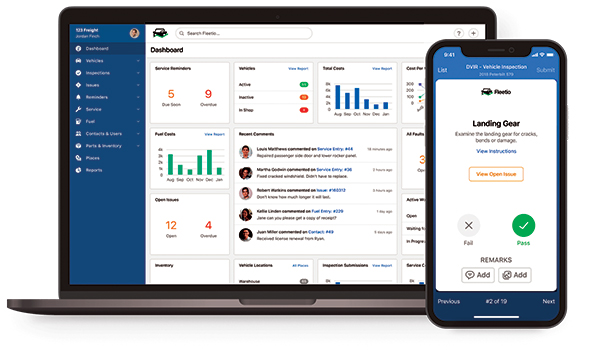
The Fleetio app allows drivers to submit DVIRs electronically. (Fleetio)
What’s more, in-cab systems can require drivers to perform a pre-trip inspection after logging in and before beginning their work and perform a post-trip inspection at the end of the day when they log off.
“The option of doing it or not doing it now that we’ve entered into the ELD (electronic logging device) phase has changed,” said Dave Walters, senior solutions engineer for transportation technology supplier Trimble Inc.
Historically, inspections were done on paper, and sometimes that paper might not have made its way into the maintenance shop. Trimble’s fleet management service integrates with the DVIR part of the process.
“When the driver inspection is done, the data goes directly to the shop maintenance system,” Walters said, adding that it is filed away if no defects are reported. “If there is a defect, the shop has to take some type of action.”
If it is a critical defect, the shop will take action right away, either bringing a driver in or sending out a vendor, Walters said. If it is a noncritical defect, such as a seat squeaking or a radio station not working, the system tracks it, and technicians can address the issues when the trucks come into the shop.
Establishing Accountability
Southeastern Freight Lines utilizes its telematics devices to input DVIR that allows the driver to review the previous report and sign off on the form electronically.
“It also provides the driver the ability on the post-trip to document any issues that he experienced during this assigned scheduled run,” said Lee Long, director of fleet services at SEFL.
The fleet, based in Lexington, S.C., ranks No. 31 on the for-hire TT100.
All of Southeastern Freight Lines’ DVIRs are run through its service provider, Innovative Software Engineering, a Trimble company, and housed there for compliance with DOT guidelines.
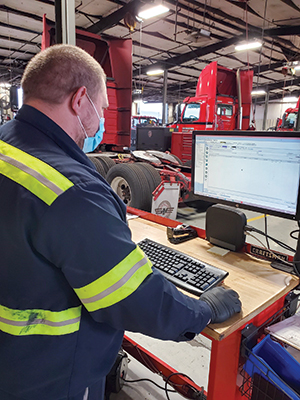
Southeastern uses work due reports that refresh routinely to keep track of repairs. (Southeastern Freight Lines)
Any driver write-ups with a deficiency are imported into the fleet’s computerized maintenance system, Cetaris, which lists the defects that are currently in need of attention at that location, Long said.
“It is all electronically handled. Our system provides work due reports that refresh routinely so we can see what has been requested for repair throughout the day,” he said.
SEFL can review requests — either by shop, region or systemwide — to review most common write-ups, Long said. “These are ‘pulled in’ to a work order as being the primary reason for repair, and then a standard job is assigned to correct the defect and update the DVIR electronically,” he said.
While there are standard areas drivers need to inspect, fleets can use technology to customize their lists based on the commodity being hauled or the type of equipment, said Renaldo Adler, principal of asset maintenance, fleets and service centers at Trimble.
“That is useful in equipment with a liftgate or a tanker with pumps,” he said.
Geotab Drive’s DVIR list is customizable to include components outside of the mandatory list, such as tie-down straps and pushcarts.
“Geotab Drive gives companies the flexibility to define what areas are of interest for their vehicles and what defects they consider critical for their pre- and post-trip inspections,” said Stephen White, senior business development manager for heavy truck at Geotab.
Trimble’s Walters added that alternative fuel vehicles, such as those powered by natural gas or electricity, also have different types of inspection requirements.
“That is getting more complex as the different types of assets grow inside of fleets,” he said.
Zonar’s Fakkema said its EVIR technology is best suited for COVID best practices and policies, and added that the virus has accelerated the move to digital and touchless systems.
“This technology has been around for years, but the lingering fleets that were still using paper for log management have been moved to tablets and phones to eliminate the contact of a paper record handoff,” he said.
Due to COVID-19, Southeastern Freight Lines has requested that drivers not enter the shop.
“We do everything electronically, so that really helps enforce that request,” Long said. “There will always be the social interaction between the driver and the tech, but we do that from a social distancing perspective now. There is no handoff of paperwork.”
With Fleetio, information is relayed in real time. A fleet manager or administrator is immediately notified of an issue identified during the inspection, said Matthew Dziak, lead content marketing manager for Fleetio. He also noted that its maintenance shop integration enhances maintenance workflows.
“It provides visibility into the entire process and the ability to collaborate in real time on maintenance tasks,” he said, adding that fleet managers can electronically approve line-item specific repair orders from third-party shops while also consolidating billing into a monthly invoice for all completed work.
Geotab Marketplace’s White added that during the DVIR defect process, maintenance partners receive the defects that drivers log in their DVIR and automatically create a repair order at the fleet’s repair facility or a contracted maintenance facility. “Once the facility completes the necessary repairs, it will be sent back to the driver’s DVIR for the driver to certify that the repair was made.”
Technology can allow drivers to take photos of items needing repair.
“A picture is worth a thousand words, and not having to write out those words is a tremendous time-saver for a driver,” Dziak said, adding that a fleet manager can analyze the submitted photograph and begin the maintenance process to avoid further complications or downtime.
Driver Training
Driver training is one of the most effective ways to ensure proper pre- and post-trip inspections, Lasko said.
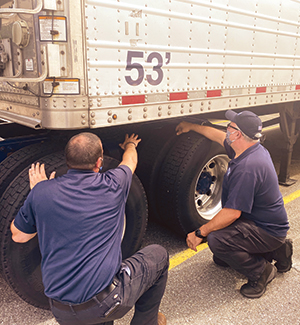
Driver training is one of the most effective ways to ensure proper inspections. (Boyle Transportation)
“When we hire, we do a comprehensive five-day orientation. We spend a good bit of time on how to properly inspect equipment,” he said, adding that Boyle Transportation supplements its initial training with weekly meetings.
To stay in touch with drivers during the pandemic, management at Carbon Express, based in Wharton, N.J., started a weekly group conference call with drivers, who are broken into groups. Carbon Express’s shop maintenance director is on the call with drivers, and CEO Steve Rush said an unintended benefit of the calls is that they have made drivers more aware of the need to care for equipment.
“In those calls, someone might say, ‘Who left me a flat tire?’ Someone else said, ‘Hey I picked up a tank truck today, and someone didn’t leave the information on the last commodity,’ ” Rush said. “That has been a big find for us during COVID. It not only helps make sure drivers are doing the right inspections but also builds camaraderie.”
C.R. England hosts weekly Facebook Live events on driver-only pages and hosts conference calls so drivers can connect with their fleet managers.
“We did one for Brake Safety Week. We went through everything they need to look for on their brakes and offered tips and tricks for checking their brakes,” Hatch said. “It is really helpful, and the drivers really like it. I have drivers who will call me or send me an email to dig more in-depth on a topic.”
Hatch noted that the company also posts guidance on the driver-only pages so drivers can download them. She also throws out challenges during the live events.

What are industry executives doing to help bring more women into the fold, not only as drivers, but in leadership roles? Host Michael Freeze talks with Ellen Voie of Women In Trucking and Debora Babin Katz of TrucBrush Corp. Hear a snippet, above, and get the full program by going to RoadSigns.TTNews.com.
“I’ll say, ‘Challenge your tech to make sure they’re greasing your slack adjusters,’ ” Hatch explained. “We’ll put the forms up on their pages so they can download it. I get on and answer any questions that any of them have and walk through it with them.”
Maintenance is also a big part of drivers’ performance bonuses at Boyle Transportation.
“Are they submitting DVIRs and submitting issues with equipment in a timely way? There is an incentive for our drivers to take the initiative on maintenance,” Lasko said.
What’s more, Boyle Transportation pays a bonus for each clean CVSA inspection, which incentivizes drivers to do pre- and post-trips and communicate with the maintenance department.
“They get $100 for a clean Level I, $80 for a clean Level II, and $60 for a clean Level III,” Lasko said. “We’re really proud of our CSA scores.”
Hatch recommended that drivers need to make a thorough pre-trip inspection a habit.
“If you’re proactive, it will save you a lot of time. You won’t be sitting waiting for a road service truck to be serving you,” she said. “Also, you’re going to be on time if you’re doing this proactively because you won’t be sitting on the side of the road.”
Want more news? Listen to today's daily briefing:
Subscribe: Apple Podcasts | Spotify | Amazon Alexa | Google Assistant | More



